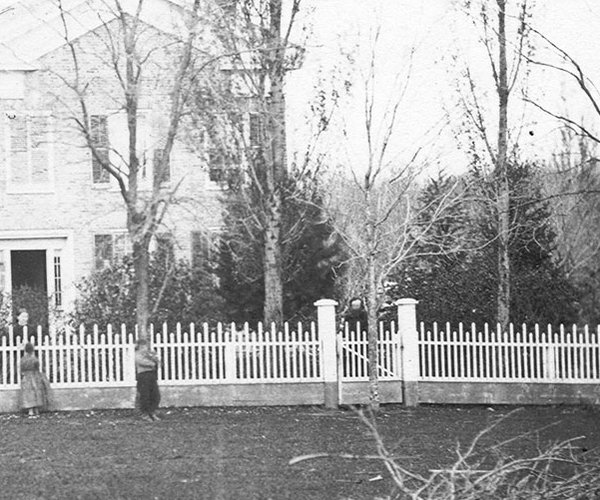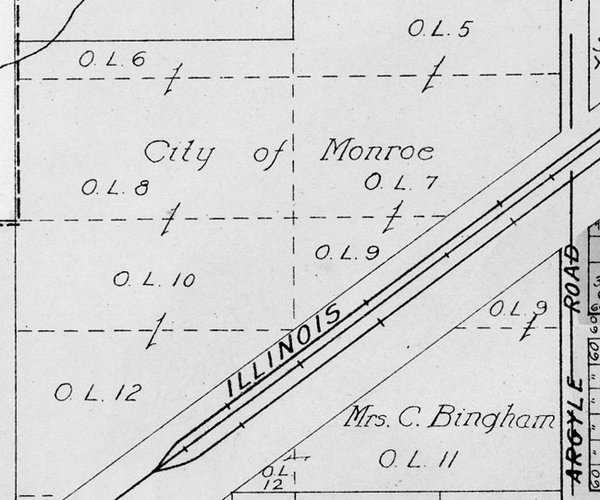Many people who are familiar with early Monroe history may never have heard of Peter Wells, even though they may have noticed the “Wells Block” on the east side of the Square, which he built in 1894. By the time you have read this column and the next six, I hope that you will realize how much of a difference Peter made in our downtown area. You’ll also realize how much respect the editor of the Monroe Sentinel and the people of Monroe had for “Uncle Peter.” You may also be impressed by how quickly the buildings rose in those days, in spite of the equipment available then.
Wells was born in Muskingum County, Ohio on November 2, 1814 and moved with his parents, Matthew and Sarah, to Indiana in 1828. There he married Jane Bowman, a native of Virginia, in 1834. They moved to Clarno Township the following year where he purchased 120 acres in Section 22 under a land patent. His obituary stated that he was a “poor man” at that time. The 1840 census shows that they had two sons and a daughter. A search of the land records from the 1840s shows that he purchased and sold many properties in that area, some of them more than once.
The 1850 census showed that he had already accumulated real estate valued at $3,400. By then they had six children ranging in age from 1 to 14 years old. In addition, two sons had passed away in August 1844, according to the family tombstone in Greenwood Cemetery. Another infant son also passed away, but no dates or ages were given. His wife, Jane, died on February 27, 1853 leaving 39-year-old Peter with eight children between the ages of 3 and 17.
Things had changed considerably for Peter by 1860. He had married Julia, widow of John Kepler, on October 11, 1853, less than eight months after losing his first wife. His 10-year-old daughter had also passed away in March 1856. The census showed only six of their seven living children still at home, but they were listed in two separate houses. There were also three farmhands living with them. The census showed that he had accumulated 680 acres of improved and 220 acres of unimproved real estate worth $25,000 plus $3,000 in personal estate. His livestock included 12 horses, 12 milch cows, 2 working oxen, 35 other cattle, 28 sheep, and 100 swine valued at $1,800. They had produced 1,000 bushels of wheat and 2,000 bushels of Indian corn as well as 120 pounds of wool within the year.


According to the 1861 plat map, Peter owned 240 acres with a home in Section 22, 80 acres with a home in Section 21, as well as an additional 80 acres in Section 20. Peter and Julia moved to Monroe sometime in the 1860s. It is unknown where their other land was located, but they sold about 100 acres of land two decades later on June 24, 1889 to each of two of their children. Adeline McCammant’s land was in Section 28 while Charles Wells’ land was in Section 20. Peter purchased two lots south of Lincoln Park and one lot west of where the Middle School now sits from Lydia Shuey on September 25, 1865 for $400. Shortly afterwards they sold the single lot for $200. This could be when they built their house and moved to Monroe.
The couple still owned property in Clarno Township as evidenced by an article in 1868. A two-story frame house that they rented to John Butler was destroyed by fire about 10:00 on Sunday, January 26 from a defective flue. Fortunately, the family was home and “succeeded in saving most of the property that was in the house.” Peter would experience several more fires to his property.
It is unknown for how many years the family had lived in Monroe when the 1870 census was taken. Only Peter, 55, Julia, 55, and Joshua, 20, were living in the house [location unknown], where they employed a 14-year-old female domestic servant. Peter was still listed as a farmer and had accumulated $26,000 of real estate and $12,000 in personal estate. It is unknown how much farmland he still owned at this time.
By April 21, 1874 Wells was talking of erecting “another building” on his block east of the Sentinel office [located on the southeast corner of the square, believed to be where Goetz Theatre is located]. It was reported the following week that he had begun the erection of a store building “south of the Empire Block,” for the use of J. H. Foster’s furniture store. The frame building would be 21 by 64 feet and veneered by brick. He hadn’t decided at that time if the second floor would be a hall or not. By June 17, the first story of the new building was nearly up and would “soon be a lasting monument to its owner’s enterprise.”
It was announced on January 5, 1875 that Peter had purchased yet another building, owned by the heirs of the late Thomas Banks. Wells and his son, Matthew, planned to operate the business in that building that had been relinquished by a Mr. Kahly; Kahly would remain employed by Wells. Wellswould fill up the stock “so depleted by the energetic assignee, H. Durst.”
Peter purchased the lot east of the Sentinel office from John E. Dixon on May 6, 1875 for $725. This gave him room to build a two-story brick block that could have “three more store rooms.” The editor added, “A few more men such as Peter in a town would make all waste places into respectable places for business.” It was announced two months later that he planned to erect a building “just south of the old American House,” on 16th Avenue south of the Square.
You’ll learn much more about what contributions Peter Wells made to the downtown area in the next six columns.
— Matt Figi is a Monroe resident and a local historian. His column will appear periodically on Saturdays in the Times. He can be reached at mfigi48@tds.net or at 608-325-6503.





